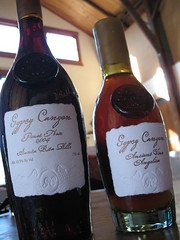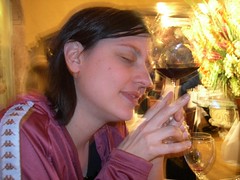Gypsy Canyon
 Over a century ago, a settler/farmer nestled himself into the snug, lush Gypsy Canyon and planted some vines, probably to make wine for his own family. Other than a few incomplete clues in local records, that's about all we know. Those vines survived, uncultivated, long after their original tender passed, under a thick layer of brambles and brush.
Over a century ago, a settler/farmer nestled himself into the snug, lush Gypsy Canyon and planted some vines, probably to make wine for his own family. Other than a few incomplete clues in local records, that's about all we know. Those vines survived, uncultivated, long after their original tender passed, under a thick layer of brambles and brush.Deborah Hall and her late husband, William, discovered these vines when they bought the property in 1994 and cleared away the brush. Believing them to be Zinfandel, Hall sold the fruit to local winemakers for a couple of years before learning through DNA testing at UC Davis that they were actually Mission vines.
Mission vines are rare now; only about ten acres still exist in California, three of which belong to Hall. Not particularly viable for dry style wines, the Mission grape was historically used to make sweet wines, as Hall learned through her research. Following a recipe written in 1891 by Emile Vache, Hall created a "California Original Angelica" from the fruit, a rich, heady fortified wine that smells and tastes of honey, dried apricots, earth and herbs.
In 2004, she released the wine she had originally been encouraged to make--Pinot Noir. It's a true Burgundian style, unfiltered and full of great, earthy aromatics.
What's special about these wines--and what you'll pay for---is the whole package.
Hall has a vision she pursues, which she calls "history in a bottle": handmade wines, organically and biodynamically farmed, just as they would have been in the 19th Century. Handblown glass bottle with a traditional, embossed seal, handmade paper and dipped in beeswax. She is currently trying to move away from commercial yeasts back to native to complete the equation.
She considers her clientele "individuals with a sense of discernment and with an appreciation for real handmade wine."
Despite the admiration I felt for her in that she had made this vision manifest beautifully, I was troubled by the feeling that her product was intended not just for those who might be able to "appreciate real handmade wine", but for those who could afford it, as a luxury item. Even the tasting experience, complete with two cheeses from a shop in Beverly Hills specially selected to pair with each wine, is one of the most expensive in Santa Barbara County, at $25 per guest, and can only be purchased by appointment (I should mention here, to be fair, that this money goes to the local Humane Society).
The two wines themselves are quite good. But what costs so much is Hall's idea of authenticity, of historical aesthetic. I think this should be pointed out to wine enthusiasts who are curious about what they'll get for that price tag. Listening to the story of the vines and the bottle's design, holding the heavy artisan glass, the look of the label and the feel of the real beeswax are the greater part of the money.
*******
Clinkies.





0 Comments:
Post a Comment
<< Home